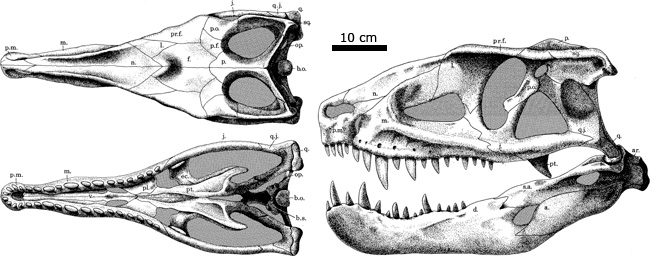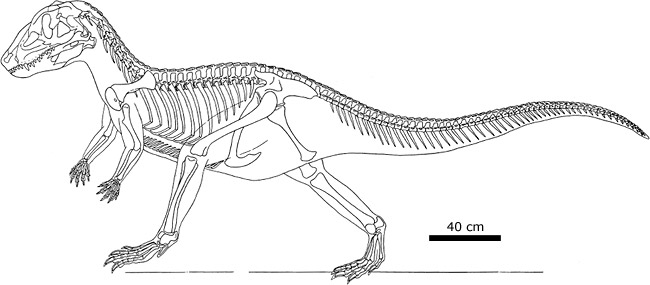
Rauisuchia
Big-headed dinosaur-like reptiles
Rauisuchids were very similar to ornithosuchids: big heads, sharp teeth, long hind legs, and scales on their backs. They seem to have been more successful than ornithosuchids, though, as rauisuchid fossils have been found all over the world. Two of the best known rauisuchids are Saurosuchus from South America and Postosuchus from the American Southwest. These animals were very large for non-dinosaurs — up to six meters (20 feet) long and with heads 60 cm (two feet) long — and they were the top predators of the Middle and Upper Triassic. Like ornithosuchids, rauisuchids are so dinosaur-like that they have sometimes been mistaken for dinosaur ancestors or even for actual dinosaurs.
See CT scans and 3D models of the skull of Saurosuchus on the DigiMorph website.

 Dorsal (top left), ventral (bottom left), and lateral views of the skull of the poposaurid Postosuchus.  Skeletal reconstruction of Postosuchus. |
Ctenosauriscids
Ctenosauriscids (TEEN-o-sore-ISK-ids) were sail-backs. Like Dimetrodon and Spinosaurus, they had long spines on their backbones that probably supported a big sheet of skin. This is yet another case of convergent evolution. Dimetrodon was an early mammal relative, Spinosaurus was a theropod dinosaur, and ctenosauriscids were related to crocodiles. All of these animals evolved their sail-backs independently. And they all had close relatives that lacked sails. The sails may have evolved to help one species recognize members of its own kind, or for some other kind of display. They probably weren't for keeping the animals warm, since their close relatives did not have sails but were just as successful. Fossils of ctenosauriscids have been found in Arizona, England, Germany, Tanzania, and China. The Chinese form, Lotosaurus, is unusual because it has a short head and a toothless beak. It may have been a plant-eater, although turtles also have beaks and they eat a wide range of plants and other animals.
Other than Lotosaurus, most ctenosauriscids are not very well known, and for a long time the relationships of the group were a mystery. Then in 2003 new material of Arizonasaurus was described. Arizonasaurus, from the Middle Triassic Moenkopi Formation of Arizona, was previously only known from a single jaw bone. The new fossils included a mostly complete skeleton — with a sail-back. The fossils show that Arizonasaurus was a ctenosauriscid and that ctenosauriscids were closely related to rauisuchids. Rather than having a toothless beak like Lotosaurus, Arizonasaurus had long jaws full of sharp teeth, much like Saurosuchus or Postosuchus.
 A reconstruction of the ctenosauriscid Arizonasaurus based on the bones that have been recovered. |
Shuvosaurines
Ctenosauriscids are pretty weird, but shuvosaurines were just as bizarre. Like ornithosuchids and rauisuchids, shuvosaurines have been mistaken for theropod dinosaurs. Like ctenosauriscids, they were only known from fragmentary material for a long time, but new discoveries have given us a much better understanding of these animals. Shuvosaurines include Shuvosaurus and Effigia from the American Southwest, and Sillosuchus from Argentina. Shuvosaurus was originally described as a primitive ornithomimosaur, or ostrich dinosaur, but it was only known from a partial skull. The skull has a toothless beak, but instead of being shaped like a turtle's beak, like that of Lotosaurus, the beak of Shuvosaurus was shaped more like the bill of an ostrich. Another set of bones from the same quarry as Shuvosaurus was also very dinosaur-like, and it was given the name Chatterjeea. The Chatterjeea remains lacked a head, and some paleontologists thought that Shuvosaurus might be the skull of Chatterjeea. But there was no way to know for sure. Then Effigia was described in early 2006. Effigia had a Shuvosaurus-like skull and a Chatterjeea-like body. It had long hind legs and short front legs, so it probably walked on its hind legs. It had a long neck and an ostrich-like head. In fact, the similarities between Effigia and the ostrich dinosaurs of the Jurassic and Cretaceous are striking — still more convergent evolution. Shuvosaurines seem to be closely related to Lotosaurus, and they may have inherited their beaks from a Lotosaurus-like ancestor — although if they did, they lost the sail-back in the process. It is now pretty certain that ostrich dinosaurs ate plants, and shuvosaurines also may have been herbivores. And it is likely that Shuvosaurus and Chatterjeea are the head and body of a single animal that was closely related to Effigia but not identical. If an animal is mistakenly given more than one name, the oldest name is the one that sticks (this is why "Brontosaurus" is now known as Apatosaurus). So Chatterjeea should probably be dropped in favor of Shuvosaurus.
Sources
|
||
Text by Matt Wedel, 5/2007. Postosuchus images used with permission of the Royal Society of London: from Chatterjee, S. 1985. Postosuchus, a new thecodontian reptile from the Triassic of Texas and the origin of tyrannosaurs. Philosophical Transactions of the Royal Society of London, B 309:395-460. Arizonasaurus images courtesy of Sterling Nesbitt: from Nesbitt, S.J. 2005. Osteology of the Middle Triassic pseudosuchian archosaur Arizonasaurus babbitti. Historical Biology 17(1):19-47.